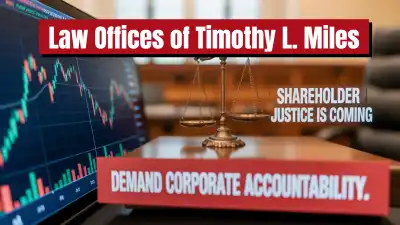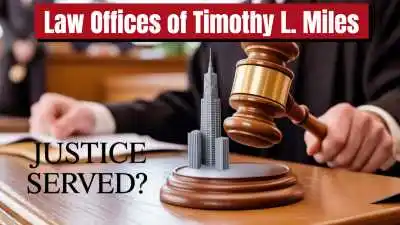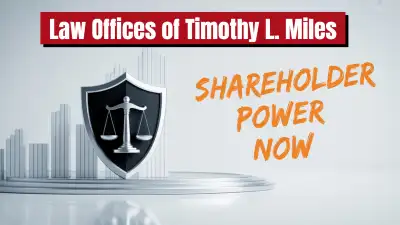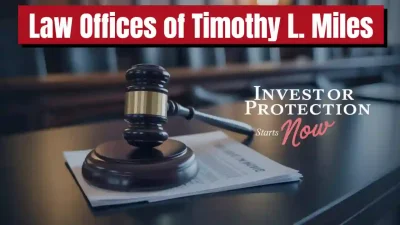LAW OFFICES OF TIMOTHY L. MILES
TIMOTHY L. MILES
(855) TIM-M-LAW (855-846-6529)
[email protected]
(24/7/365)
Informed shareholders, equipped with comprehensive educational materials and relevant statistics on litigation and voting rights, are better positioned to make strategic decisions regarding potential lawsuits and corporate governance. This knowledge empowers them to assess the viability and timing of legal action following significant losses, while also enabling them to actively participate in shaping corporate behavior through their voting power and understanding of governance mechanisms. Ultimately, an educated shareholder base can foster greater accountability and transparency, leading to more strategic litigation choices and a stronger voice in guiding the company's future.
Timothy L. Miles, Esq.

In today’s complex financial landscape, securities litigation has become an increasingly significant concern for investors. According to recent data, the number of mega “Disclosed Dollar Loss” filings reached a record high of 27 in 2024, with the average DDL nearly doubling the historical norm to $438 million. These statistics underscore a troubling reality: investors face substantial risks of financial harm due to potential securities violations, with recovery mechanisms often shrouded in procedural complexity and legal nuance.
The ability to navigate securities litigation effectively can mean the difference between substantial recovery and complete loss of investment value. Yet many investors—both individual and institutional—lack comprehensive understanding of their rights, the procedural frameworks governing securities class actions, and the strategic considerations that influence litigation outcomes. This knowledge gap creates vulnerability in an environment where the likelihood of a U.S. exchange-listed company becoming the subject of a core federal filing increased to 3.9% in 2024.
The Investor Hub serves as a centralized resource designed to equip investors with essential knowledge regarding securities litigation. From understanding the critical deadlines for filing as a lead plaintiff to navigating the settlement process, this resource provides authoritative guidance on all aspects of securities class actions. The information contained herein addresses the procedural mechanics of securities litigation, the substantive rights of shareholders, and the strategic considerations that influence litigation outcomes.
Within these pages, investors will find detailed explanations of lead plaintiff selection criteria, class certification requirements, settlement evaluation frameworks, and the role of regulatory bodies in securities enforcement. The Hub also provides insights into emerging trends in securities litigation, including the rise in COVID-19-related filings, the decline in SPAC and cryptocurrency litigation, and the growing significance of artificial intelligence as a litigation category.
Whether you are an institutional investor managing substantial holdings, an individual shareholder concerned about potential securities violations, or a market participant seeking to understand the securities litigation landscape, the Investor Hub offers the authoritative information necessary to protect your interests and make informed decisions regarding participation in securities class actions.
Investors seeking to understand their rights in securities litigation should familiarize themselves with the following essential resources:
The Private Securities Litigation Reform Act of 1995 (“PSLRA”) establishes specific procedural requirements regarding lead plaintiff selection in securities class action lawsuits. When a securities class action is filed, the plaintiff who files the initial complaint must publish a notice announcing the filing within 20 days. This notice alerts potential class members of the pending litigation and their right to seek appointment as lead plaintiff.
Following publication of this notice, any member of the purported class may file a motion to serve as lead plaintiff within 60 days. This statutory deadline is strictly enforced by federal courts. Failure to file a timely motion for appointment as lead plaintiff will typically result in forfeiture of the opportunity to serve in this capacity, absent extraordinary circumstances that might justify equitable tolling of the deadline.

The PSLRA establishes a rebuttable presumption that the “most adequate plaintiff” to serve as lead plaintiff is the person or group that:
The financial interest analysis typically considers:
This presumption may be rebutted only upon proof that the presumptively most adequate plaintiff:
Courts have consistently held that the lead plaintiff selection process is not merely a “race to the courthouse” but rather a substantive evaluation of which plaintiff is best positioned to represent the interests of the class.
Below is sample from our frequently asked questions pages which has nearly 400 frequently asked questions. We hope you enjoy.
The class period in a securities class action refers to the specific temporal interval during which the alleged fraudulent activity occurred and during which investors who purchased or otherwise acquired securities may be entitled to recovery. The class period typically commences when the defendants allegedly made the first materially false or misleading statement or omission and concludes when the truth was fully disclosed to the market through a corrective disclosure.
The class period is a critical element in securities litigation because it:
Courts rigorously analyze the proposed class period to ensure it accurately reflects the duration of the alleged fraud and the period during which investor losses are attributable to the defendants’ conduct.
The lead plaintiff in a securities class action is appointed by the court to oversee the litigation on behalf of the class, including selecting and directing counsel, making strategic decisions, and potentially negotiating settlement terms. The lead plaintiff has fiduciary duties to the class and must act in the best interests of all class members.
A named plaintiff, by contrast, is simply a plaintiff who has been identified by name in the complaint. While all lead plaintiffs are named plaintiffs, not all named plaintiffs are designated as lead plaintiffs. Named plaintiffs who are not appointed as lead plaintiffs typically have a limited role in directing the litigation.
Damages in securities class actions are typically calculated using economic models designed to isolate the stock price declines attributable to the revelation of the alleged fraud, as distinguished from market-wide or industry-specific factors. The predominant methodology employs an “event study” analysis, which:
The PSLRA limits recoverable damages to the difference between the purchase price paid by the plaintiff and the mean trading price of the security during the 90-day period beginning on the date of the corrective disclosure, subject to certain exceptions.

To proceed as a class action, a securities fraud case must satisfy the requirements of Federal Rule of Civil Procedure 23. The class certification process involves a rigorous judicial analysis of:
Rule 23(a) Prerequisites
Rule 23(b)(3) Requirements
The class certification decision is a pivotal moment in securities litigation, as denial of certification often leads to settlement or dismissal, while grant of certification significantly increases settlement pressure on defendants.
In securities fraud cases, courts frequently focus on the “fraud-on-the-market” theory, which creates a rebuttable presumption of class-wide reliance on material misrepresentations made to the public in an efficient market. Defendants may rebut this presumption by showing that the alleged misrepresentation did not impact the stock price.

Shareholders possess specific rights in the context of securities litigation, including:
Right to Recovery
Shareholders who purchased securities during the class period and suffered losses due to alleged fraud have the right to seek recovery of their damages through participation in a securities class action.
Right to Notice
Class members have the right to receive notice of the pendency of the action, proposed settlements, and their right to opt out of the class.
Right to Object
Class members have the right to object to proposed settlements, attorney’s fee requests, or other aspects of the litigation that may affect their interests.
Right to Opt Out
Class members have the right to exclude themselves from the class and preserve their ability to pursue individual claims.
Right to Lead Plaintiff Status
Shareholders with substantial losses have the right to seek appointment as lead plaintiff and direct the litigation on behalf of the class, subject to the PSLRA’s selection criteria.
Inspection Rights
Outside the litigation context, shareholders generally have rights under state law to inspect corporate books and records, which can be valuable in investigating potential securities fraud.
Securities class actions typically progress through the following stages, though the specific timeline can vary significantly based on the complexity of the case and the court’s docket:
The settlement process in securities class actions involves several distinct phases:
Settlement Negotiations
Settlement negotiations may occur at various stages of the litigation, often following significant rulings such as decisions on motions to dismiss or class certification. Mediation with experienced neutrals is common in facilitating resolution.
Preliminary Approval
Once the parties reach agreement on settlement terms, they submit a stipulation of settlement to the court for preliminary approval, which includes:
Notice to Class
Following preliminary approval, notice is provided to class members, typically through:
The notice describes the essential terms of the settlement, the process for submitting claims, and the procedures for objecting to or opting out of the settlement.
Final Approval Hearing
The court conducts a “fairness hearing” to determine whether the settlement is fair, reasonable, and adequate, considering factors such as:
Claims Administration
Following final approval, the claims administrator:
The distribution of settlement proceeds typically occurs 6-12 months after final approval of the settlement.
Investors must carefully weigh the advantages and disadvantages of opting out of a securities class action:
Potential Advantages of Opting Out
Potential Disadvantages of Opting Out
The decision to opt out is highly fact-specific and typically warrants consultation with experienced securities litigation counsel. Institutional investors with substantial losses are more likely to benefit from opting out than retail investors with smaller positions.

Regulatory bodies play a significant role in securities litigation through their enforcement actions and regulatory oversight:
Securities and Exchange Commission (SEC)
The SEC’s role includes:
Private securities litigation often follows or parallels SEC enforcement actions, with private plaintiffs benefiting from the findings and evidence developed in the regulatory proceedings.
Department of Justice (DOJ)
The DOJ prosecutes criminal violations of the securities laws, including:
Criminal convictions can significantly strengthen parallel private securities litigation through collateral estoppel or by providing persuasive evidence of wrongdoing.
Financial Industry Regulatory Authority (FINRA)
FINRA, a self-regulatory organization, regulates broker-dealers and:
FINRA arbitration provides an alternative forum for certain securities-related claims, particularly those involving unsuitable investment recommendations, unauthorized trading, or other broker misconduct.
Corporate governance practices substantially influence securities litigation risk and outcomes:
Board Composition and Independence
Companies with more independent boards and robust governance structures typically face:
Disclosure Controls and Procedures
Effective disclosure controls and procedures, including:
These measures can significantly reduce litigation risk and strengthen defenses in the event of litigation.
Insider Trading Policies
Comprehensive insider trading policies and procedures, including:
These safeguards can prevent conduct that often triggers securities litigation and demonstrate good faith efforts to comply with securities laws.
Whistleblower Programs
Effective internal reporting mechanisms for potential misconduct can:
Increase in Filings of Securties Class Actions
In 2024, there were 229 new federal securities class action lawsuits filed, maintaining the same level as the previous year. Notably, the technology and healthcare sectors accounted for a significant portion of these filings, reflecting ongoing scrutiny in these industries.
Filing Activity:
Industry Trends:

Upcoming lead plaintiff deadlines:
See all deadlines for all securities actions on the Lead Plaintiff Deadlines page.
Securities Class Action Lawsuits promote investor protection by empowering investors to seek redress for losses suffered due to corporate misconduct and violations of securities laws. Investor protection is the framework of laws, regulations, and practices designed to safeguard investors from unfair, deceptive, or manipulative practices in the financial markets. It aims to foster confidence in financial markets, encourage investment, and prevent financial losses due to fraudulent activities.
Institutional investors, such as pension funds, mutual funds, and insurance companies, play a significant role in securities class actions. Their participation is crucial not only because of their financial stakes but also due to their ability to influence the direction of the litigation.
Institutional investors also serve a monitoring function, ensuring that companies adhere to legal and ethical standards. When management fails to comply with their demands, these investors can exert their influence by filing proxy resolutions or engaging in litigation. This monitoring role is essential for protecting the interests of all shareholders.
Research indicates that institutions serving as lead plaintiffs are associated with more favorable litigation outcomes. This includes a lower likelihood of case dismissal and larger settlement amounts.
In addition to financial recoveries, the involvement of institutional investors is linked to positive changes in corporate governance. These investors often advocate for reforms that enhance board independence and accountability, thereby reducing the likelihood of future misconduct.
Recent years have seen a notable increase in the participation of institutional investors in securities fraud class actions. This trend reflects a growing recognition of the importance of collective action in addressing corporate misconduct.
We hope you find our Investor Hub education on your investment journey. If you have any questions about the Investor Hub, securities litigation, or on-going securities class actions, please contact the Law Offices of Timothy L. Miles, at no charge, for a free case evaluation. Call today and see what a securities litigation lawyer can do for you.
855/846-6529 or via e-mail at [email protected]. (24/7/365).
Timothy L. Miles, Esq.
Law Offices of Timothy L. Miles
Tapestry at Brentwood Town Center
300 Centerview Dr. #247
Mailbox #1091
Brentwood,TN 37027
Phone: (855) Tim-MLaw (855-846-6529)
Email: [email protected]
Website: www.classactionlawyertn.com
Facebook Linkedin Pinterest youtube
